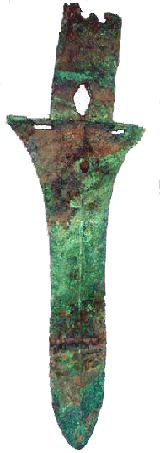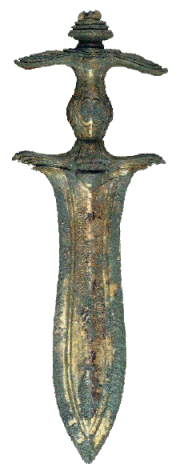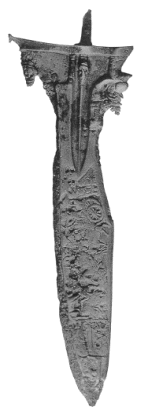|
The art of metal work arrived in Indonesia during the Bronze age from South China. Dong Son bronze drums, dated from as early as the fifth century BC, have been found throughout the archipelago, and some of them are believed to have been cast in Bali. The Dong Son culture is also known for its unique daggers with an anthropomorphic hilt, which has been compared to the Keris Sajen. But the source of South Asian metal work dates back to the Chinese Shang Dynasty with the "Ge" dagger-axe (item 1), which were the first weapon in Chinese history that was not a dual-use tool for hunting or agriculture. A "Ko" dagger (National Museum of Indonesia inv n°3259) coming from Palembang, South Sumatra, is an evidence of the existence of relationship between Sumatra and China in prehistoric times. |
|||||||||||||||||||||
Origin of the Keris Keris, heirlooms and other traditional weapon is one aspects of Indonesian culture, indeed after our forefathers acquired iron technology. Various stone temples built ca. 10th century A.D. proves that people inhabiting Indonesia at the time had a good master of ironworks, so they can create high art sculpture. But whether the Indonesian at the time had known keris culture as known now, the experts are only guessing. Most ancient Relief which shows ironworks is found at the stelae found at Dakuwu Village, Grabag region, Magelang, Central Java. Examining the form of the letters, it is approximated that the stelae is made about 500 A.D. The letter used is the Pallawa letter. The language used is Sanskrit. The Stelae wrote about a clean and clear springwater. On the stelae there are pictures, such as: trident, axe, crescent, blade and knife which forms is similiar to the keris made by Nyi Sombro, a woman empu from the Pajajaran Era. There's also pictures of clay flask, kalasangka and lotus flower. Clay flask in the Javanese philosophy is the symbol of knowledge, kalasangka symbolized the eternal, while the lotus symbolized natural harmony.
A Few Theories Many scholars have analyzed about the history and progress of keris and other heirlooms. G.B. Gardner in 1936 proposed that keris is a progress form of blade weapon from the prehistoric, which were made from the tails of mantaray which is cut at the base, and the shaft is cloth wrapped. In this way, the weapon can be held and carried around. It became a dangerous and deadly weapon at the time. Meanwhile, GRIFFITH WILKENS in 1937 think that the keris culture is a new knowledge that arose in the 14th or 15th century. He said that the keris shape is a continuation of the spear form which are used of people in Australasian region. From the eye of the spear comes the short / stabbing weapon, which is known as keris. He reasoned since the spear is very long, it is not easy to carry around. The spear is cumbersome if used in the forest. Since at that time iron is hard to find, the eye of the spear is seperated from the lance to become a handheld weapon. A.J. BARNET KEMPERS has other opinion about keris origin. In 1954 the archaeleogist suspect that the keris prototype form is a continuation form of stabbing weapon from the bronze era. Keris whose hilt shaped in small human statue and integrated with the blade, is not very special according to Kempers. Kempers said that stabbing blade from the bronze culture of Dong-son are also shaped like that. The hilt form in small standing human statue in arrogant pose (malang kerik, Javanese). This is similiar to old stabbing blade found in Kalimantan, where the hilt is shaped in the form of human in arrogant pose. The development of basic shape of stabbing weapon can be compared with the development of weapons in Europe. In Europe, swords were once shaped with human form with both hand stretched wide. After the spread of Christianity, the shaped of the hilt is likened to a cross. Indonesian kerises have hilt that shaped like a human, either in standing, crooked/bent, or squatting position. This shape is similiar to the megalithic statues found in Playen, Gunung Kidul, Yogyakarta, Central Java. In later development, the shape became more artful and know known as the shape of keris hilt. (in Java it is called deder, jejeran, atau ukiran) with the various decoration known as cecek, patra gandul, patra ageng, umpak-umpak, etc. In Indonesian cultural history, the statue of human standing rather crooked is thought by some expert as symbolization of dead people. Human statue in squatting position with bended knee is thought to symbolize birth, birthing, fertility or life. It is because it's similiar to baby position in the womb of the mother. Some Western expert are not convinced that keris is made in Indonesia before the 14th or 15th century. They're basing their theory due to the fact that there's no clear pictures in the relief at the stone temples which are build before the 10th century. SIR THOMAS STAMFORD RAFFLES in his book History of Java (1817) said that, at least 30 types of weapon is known and used by the Javanese soldier at the time, including firearms. But among the various weapon, keris has a special place. Raffles also said in his book, that the Javanese soldier usually wore up to three keris at the same time. Keris which is wore on the left side is from the in-laws during the wedding (kancing gelung, Javanese). Keris wore on the right side is from his own parent. Other keris ethics and customs are written on the Raffles book. Unfortunately Raffles never mention about the history and origin of the keris culture. Whilst the "keris" term is already written in several ancient inscription. The bronze plaque found at Karangtengah, dated 748 Saka, or 842 A.D. talks about various offerings to mark Poh as a tax free region. Those offerings include 'kres', wangkiul, tewek punukan, wesi penghatap. Kres meant at that plaque is indeed keris. While wangkiul is a kind of spear, tewek punukan is a kind of double edge weapon. In the relief at Borobudur Temple, Central Java, at the lower southeast corner, there's a depiction of soldiers carrying sharp weapon similiar to keris that we know nowadays. At Prambanan Temple, also in Central Java, there's also a relief that depicts giants carrying stabbing weapon that is very keris alike. In Sewu Temple, near the Prambanan Temple, there is also a big stone guardian statue which has sharp weapon that is keris like. In the first and second edition of books written by Prof. P.A VAN DER LITH, it is said that while the main stupa of Borobudur Temple - build in 875 A.D. - is restorated, there it is found an old keris. The keris is integrated of the blade and the hilt. But the keris form is not similiar with the keris shape depicted at the relief at the Temple. That keris is now at the Ethnography Museum, Leiden, The Netherlands. Information about the keris is written by Dr. H.H. JUYNBOHL in Royal (Dutch) Catalog volume V, 1909. In the catalog it is said, that the keris is considered as ‘keris Majapahit‘, the hild is shaped like a human statue, the blade is very old. One side of the blade is worn out. The keris, which has register number of 1834, is a gift from G.J. HEYLIGERS, secretary from the local office of Kedu, in October 1845. The resident then were Hartman. The blade is measured at 28.3 cm in length, the blade itself is 20,2 cm, and it is 4,8 cm wide. The keris is straight, not wavy.
Southeast Asia from prehistory to history. Edited by Ian Glover and Peter Bellwood |






